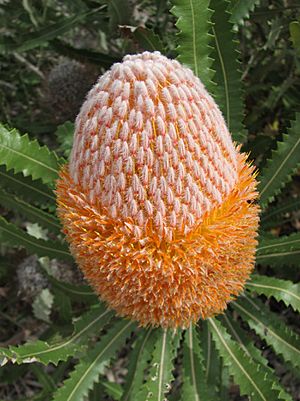Burdett's banksia facts for kids
Quick facts for kids Burdett's banksia |
|
|---|---|
 |
|
| Banksia burdettii in the Royal Botanic Gardens, Cranbourne | |
| Scientific classification | |
| Genus: |
Banksia
|
| Species: |
burdettii
|
The Banksia burdettii, also known as Burdett's banksia, is a type of shrub or small tree. It belongs to the Banksia family, called Proteaceae. You can find it growing in sandy areas north of Gingin, Western Australia. This plant can grow up to 4 meters (about 13 feet) tall. It has long, saw-edged leaves and big, bright flower spikes. These flowers start white and then turn a bright orange. They usually appear in late summer, around February and March. A scientist named Edmund Gilbert Baker first described B. burdettii in 1934. He named it after W. Burdett, who collected the first plant sample.
Contents
What Does Burdett's Banksia Look Like?
Banksia burdettii is an evergreen shrub, meaning it stays green all year. It can reach a height of about 4 meters (13 feet). Its new branches are a bit hairy, but older stems become smooth. The strong, grey-green leaves have jagged edges, like a saw. They are about 10–16 cm (4–6 inches) long and 1.5–2.5 cm (0.6–1 inch) wide. The leaves are narrow and have a flat tip.
Amazing Flower Spikes
Burdett's banksia has tall flower spikes, which are called inflorescences. These spikes are 6–10 cm (2.4–4 inches) high and stand out at the ends of the branches. They bloom between January and May, with the most flowers appearing in February and March. Each flower spike has many tiny flowers, usually around 972. The individual flowers are hairy. They are white on the outside and orange inside. As the flowers open, the spike changes from white to orange.
Seeds and Fire
After the flowers fade, the old spikes turn grey. They can develop up to 20 seed pods, called follicles. Each follicle holds two seeds. However, about 36% of these seeds might not grow. Most of these seed pods stay closed until a bushfire opens them.
Where Does Burdett's Banksia Grow?
You can find Banksia burdettii in Western Australia, specifically between the towns of Eneabba and Mogumber. It is quite common in these areas.
How Does Burdett's Banksia Survive?
Burdett's banksia is very sensitive to bushfires. Even small fires can kill the plants because their old cones burn easily. Hotter fires cause more cones to burn and open. This plant is very good at surviving fires because it is serotinous. This means it only releases its seeds after a fire.
Seed Release After Fire
The plants store many good seeds in their cones high up in the plant. After a fire, all these seeds are released at once. This helps new plants grow and replace the ones that burned. New plants usually take about four or five years to flower. This is faster than many other banksia species. The best time for fires to happen for this plant is every 10 to 20 years. Spring fires are thought to be better for new growth because there's usually more rain afterwards, which helps the seeds sprout.
Animals That Visit Burdett's Banksia
Many animals visit the flowers of Burdett's banksia.
- Honeyeaters: Several types of honeyeater birds feed on the flowers and help pollinate them. These include the white-cheeked honeyeater, brown honeyeater, spiny-cheeked honeyeater, red wattlebird, and western wattlebird.
- Cockatoos: Carnaby's black cockatoos like to eat the seeds from the pods. You might see old flower cones dropped around the plant by these birds.
- Honey Possums: The honey possum also visits the flowers to feed.
- Weevils: Small insects called weevils eat the seeds, especially from older cones.
Growing Burdett's Banksia in Gardens
Banksia burdettii is fairly easy to grow if you live in a place with a Mediterranean climate. This means it likes dry summers. It doesn't do well in places with very humid summers. It needs a sunny spot and soil that drains water well. Once the plant is established, it can handle both frost and dry periods. It prefers sun or light shade.
You don't need to do anything special to the seeds before planting them. They usually take about 20 to 42 days to sprout.
Images for kids
-
Banksia burdettii in the Royal Botanic Gardens, Cranbourne
See also
 In Spanish: Banksia burdettii para niños
In Spanish: Banksia burdettii para niños


